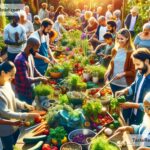The Future of Food and Community Engagement: Building a Healthier Tomorrow
Food is more than just fuel for our bodies; it shapes our communities, cultures, and even the future of our planet. As we face new challenges like climate change, population growth, and food shortages, people everywhere are asking a big question: How can we create a better future for food?
The answer doesn’t just lie in science or technology—it also depends on us, the community. When communities engage with food in meaningful ways, they can create a healthier, fairer, and more sustainable future for everyone. Let’s explore where food is headed and how getting involved can make all the difference.
The Challenges We Face
Food production today is under pressure. With 8 billion people on Earth—and more coming—we need to grow enough food without harming the planet. Traditional farming methods are working hard to keep up, but they come with problems like deforestation, water shortages, and pollution.
Additionally, climate change is making it harder to grow food. Extreme weather events like droughts, floods, and heat waves are damaging crops and making food less reliable.
Another big issue is food waste. Globally, about one-third of all food is thrown away, even though millions of people go hungry every day. Finding solutions to these challenges isn’t just about feeding people—it’s about creating fairness, reducing harm to nature, and making sure future generations have good food to eat.
The Role of Technology in Food’s Future
The future of food is exciting, thanks to advances in science and technology. Here are some innovations that could reshape the way we grow, produce, and eat:
-
Vertical Farming: Imagine farms stacked like shelves inside warehouses. Vertical farming allows crops to grow in controlled environments using less land and water. This makes farming possible even in cities, bringing food closer to people and reducing transportation pollution.
-
Lab-grown Meat: Scientists have discovered ways to grow meat in labs without raising or killing animals. This method could reduce environmental damage from livestock farming, lower greenhouse gas emissions, and address ethical concerns.
-
Plant-Based Proteins: Many companies are creating tasty alternatives to meat using plants like soy and peas. These foods can provide the same amount of nutrition as meat but with a smaller environmental footprint.
-
Precision Agriculture: Farmers can use smart tools like drones and sensors to track soil health, water levels, and crop growth. These technologies help farmers use resources efficiently and grow healthier harvests.
-
Food Waste Solutions: Apps, smart packaging, and redistribution networks are being developed to save food from the trash. These systems match surplus food from restaurants, grocery stores, and farms with people who need it.
Technology will undoubtedly play a big role in creating sustainable food systems, but sustainability is about more than gadgets. It’s also about how communities interact with food.
The Importance of Community Engagement
What would happen if communities cared more about food? The possibilities are endless! When people connect with food on a local level, they can make powerful changes. Here are some ways community engagement can shape the future:
-
Supporting Local Farms: Buying food from local farmers means fresher produce and fewer transportation emissions. Farmers’ markets and community-supported agriculture (CSA) programs give people easy access to local food and support small-scale farmers.
-
Urban Gardens and Farms: Cities don’t have as much land for traditional farming, but urban gardens can provide fresh food and green spaces where people gather. Community members can work together to grow fruits, vegetables, and herbs while building friendships and reducing food insecurity.
-
Food Education: Schools and community centers can teach people where their food comes from and how to cook nutritious meals. This knowledge can inspire healthier eating habits and more creative ways to reduce food waste.
-
Sharing and Giving: Food-sharing initiatives like community pantries use simple acts of kindness to ensure no one goes hungry. People can donate items from their kitchen, help collect surplus food, or volunteer their time to serve meals.
-
Celebrating Food Culture: Food has always been tied to culture and tradition. Through festivals, community dinners, and cooking classes, people can learn about the diverse ways food connects us all.
When communities take an active role in food systems, they don’t just solve problems—they strengthen bonds between neighbors, celebrate diversity, and create proud local identities.
What Can You Do?
You don’t have to be an expert to shape the future of food. Small actions in your daily life can add up to big changes. Here are some easy ways you can make a difference:
- Plant a garden, even if it’s just a few pots of herbs on your windowsill.
- Buy food from local farms or farmers’ markets.
- Reduce food waste by eating leftovers, freezing extras, and planning meals wisely.
- Learn new recipes and try plant-based meals.
- Support organizations in your community that fight hunger and promote sustainable food systems.
The future of food doesn’t belong to scientists, farmers, or policy-makers alone—it belongs to all of us.
Conclusion
The way we grow, share, and eat food is changing fast, and these changes bring both challenges and opportunities. While technology will help us address food shortages and environmental concerns, community engagement is just as important. When people come together to support local farmers, grow their own food, and find creative ways to reduce waste, they help build food systems that are fairer, healthier, and stronger.
The future of food isn’t just about survival—it’s about thriving as a global community. By taking small steps today, we can ensure that food continues to nourish not just our bodies but also our communities and our planet. Let’s work together to shape tomorrow’s table!
What are your thoughts about the future of food? Leave a comment below and share your ideas!


